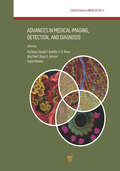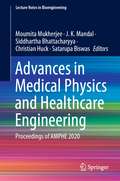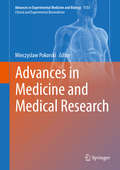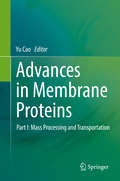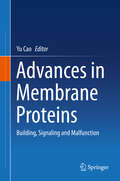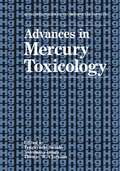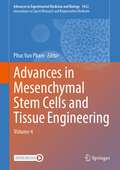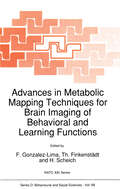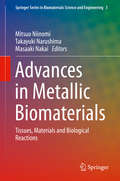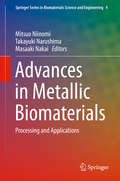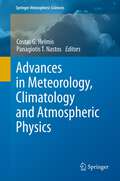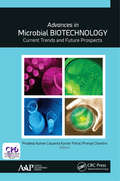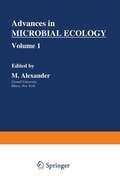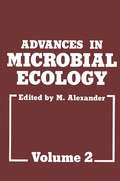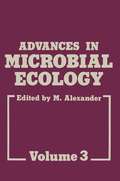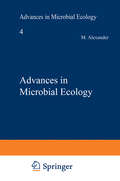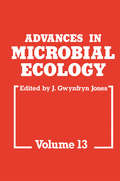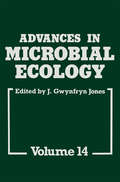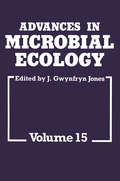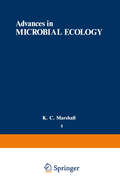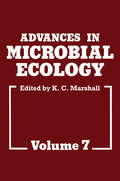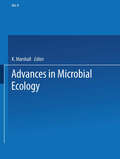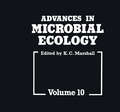- Table View
- List View
Advances in Medical Imaging, Detection, and Diagnosis (Jenny Stanford Series on Current Issues in Medicine, Volume 4)
by Gerald F. Audette S. R. Bawa Bela Patel Bruce D. Johnson Rajeev Khanna Raj BawaMedical care is the most critical issue of our time and will be so for the foreseeable future. In this regard, the pace and sophistication of advances in medicine in the past two decades have been truly breathtaking. This has necessitated a growing need for comprehensive reference resources that highlight current issues in specific sectors of medicine. Keeping this in mind, each volume in the Current Issues in Medicine series is a stand‐alone text that provides a broad survey of various important topics in a focused area of medicine—all accomplished in a user-friendly yet interconnected format. This volume addresses advances in medical imaging, detection, and diagnostic technologies. Technological innovations in these sectors of medicine continue to provide for safer, more accurate, and faster diagnosis for patients. This translates into superior prognosis and better patient compliance, while reducing morbidity and mortality. Hence, it is imperative that practitioners stay current with these latest advances to provide the best care for nursing and clinical practices. While recognizing how expansive and multifaceted these areas of medicine are, Advances in Medical Imaging, Detection, and Diagnosis addresses crucial recent progress, integrating the knowledge and experience of experts from academia and the clinic. The multidisciplinary approach reflected makes this volume a valuable reference resource for medical practitioners, medical students, nurses, fellows, residents, undergraduate and graduate students, educators, venture capitalists, policymakers, and biomedical researchers. A wide audience will benefit from having this volume on their bookshelf: health care systems, the pharmaceutical industry, academia, and government.
Advances in Medical Imaging, Detection, and Diagnosis (Jenny Stanford Series on Current Issues in Medicine, Volume 4)
Medical care is the most critical issue of our time and will be so for the foreseeable future. In this regard, the pace and sophistication of advances in medicine in the past two decades have been truly breathtaking. This has necessitated a growing need for comprehensive reference resources that highlight current issues in specific sectors of medicine. Keeping this in mind, each volume in the Current Issues in Medicine series is a stand‐alone text that provides a broad survey of various important topics in a focused area of medicine—all accomplished in a user-friendly yet interconnected format. This volume addresses advances in medical imaging, detection, and diagnostic technologies. Technological innovations in these sectors of medicine continue to provide for safer, more accurate, and faster diagnosis for patients. This translates into superior prognosis and better patient compliance, while reducing morbidity and mortality. Hence, it is imperative that practitioners stay current with these latest advances to provide the best care for nursing and clinical practices. While recognizing how expansive and multifaceted these areas of medicine are, Advances in Medical Imaging, Detection, and Diagnosis addresses crucial recent progress, integrating the knowledge and experience of experts from academia and the clinic. The multidisciplinary approach reflected makes this volume a valuable reference resource for medical practitioners, medical students, nurses, fellows, residents, undergraduate and graduate students, educators, venture capitalists, policymakers, and biomedical researchers. A wide audience will benefit from having this volume on their bookshelf: health care systems, the pharmaceutical industry, academia, and government.
Advances in Medical Physics and Healthcare Engineering: Proceedings of AMPHE 2020 (Lecture Notes in Bioengineering)
by Siddhartha Bhattacharyya Moumita Mukherjee J. K. Mandal Christian Huck Satarupa BiswasThis book presents research advances in the theory of medical physics and its application in various sectors of biomedical engineering. It gathers best selected research papers presented at International Conference on Advances in Medical Physics and Healthcare Engineering (AMPHE 2020), organized by the Department of Physics (in collaboration with the School of Engineering and Technology) Adamas University, Kolkata, India. The theme of the book is interdisciplinary in nature; it interests students, researchers and faculty members from biomedical engineering, biotechnology, medical physics, life sciences, material science and also from electrical, electronics and mechanical engineering backgrounds nurturing applications in biomedical domain.
Advances in Medicine and Medical Research (Advances in Experimental Medicine and Biology #1133)
by Mieczyslaw PokorskiThis book focuses on issues in clinical practice and research that are of general interest. The articles primarily focus on understanding the pathogenic mechanisms of diseases, their prevention, and therapy. The topics addressed include cardiovascular regulation with regard to blood pressure and heart rate variability, and to coupling blood pressure changes with subarachnoid fluid oscillations. In addition, the book discusses recent advances in the diagnostics of and targeted molecular therapy for renal and pancreatic malignancies, growth disorders, vitamin D and calcium homeostasis in children in the context of neonatal urolithiasis, and neurosurgical interventions in multifarious age-related diseases of the vertebrae. Neuropsychological aspects of patients’ quality of life and of shaping medical staff’s attitude toward patients are also addressed. The respective articles are intended to build a bridge between basic and clinical research. Further, the book enhances the current body of knowledge on diagnostics and patient treatment and offers valuable new perspectives on practical clinical issues. As such, it offers a unique resource for clinicians, family physicians, medical scholars, and professionals engaged in patient management.
Advances in Membrane Proteins: Part I: Mass Processing and Transportation
by Yu CaoThe book summarizes advances in biochemical and biophysical property of membrane proteins as well as their applications in biomedicine. It is organised into 2 themed parts. This part focuses on mass processing and transportation and provides deep and comprehensive information on specific groups of membrane proteins including channels and transporters, nuclear and cytoplasmic membrane proteins, and membrane embedded enzymes. Their structures, functions, related diseases as well as their roles in drug discovery are fully discussed. Interesting topics cover fundamental concepts, latest progress and critical puzzles yet to be solved. This work will appeal to a wide readership within the membrane structural and functional biology field. Junior scientists could use it to fast track into the field. Advanced scientists will find it helpful to gain a broader view of the field beyond their area of specialization.
Advances in Membrane Proteins: Building, Signaling and Malfunction
by Yu CaoThis book reviews recent advances regarding the biochemical and biophysical properties of membrane proteins and their applications in biomedicine. Divided into two thematic parts, this second volume addresses proteins’ formation, signaling and malfunctions. It covers a number of important membrane proteins including receptors, cell adhesion molecules, single-transmembrane proteins and viral membrane proteins, and discusses their structures, functions, related diseases, and roles in drug discovery in detail. In turn, the book elucidates the lifecycle of membrane proteins, including their synthesis and facilitated folding process, as well as QC procedures for their production. Additional topics include fundamental concepts, the latest findings, and critical puzzles yet to be solved. Given its scope, the book will appeal to a broad readership in the field of membrane structural and functional biology. Junior scientists can use it as an introduction to the field, while advanced scientists will find a broader view of the field beyond their area of specialization.
Advances in Mercury Toxicology (Rochester Series on Environmental Toxicity)
by Tsuguyoshi Suzuki Nobumasa Imura Thomas W. ClarksonThis book is based on an international meeting organized by the University of Tokyo and the University of Rochester, and is published as one belonging to the series of Rochester International Conferences in Environmental Toxicity. The meeting on "Advances in Mercury Toxicology" was held at the University of Tokyo on August 1 to 3, 1990. The invited papers are published in this book along with an "Overview" chapter that was written by the editors at a meeting held at the University of Rochester on August 1 to 2, 1991. The purpose of the meeting was to assemble leading scientists to discuss their most recent findings on the toxicology of mercury. The time was opportune. Considerable progress has been made on the environmental fate and toxicology of mercury. Recent findings have given new insight into the global model for mercury. Transport in the atmosphere extends great distances resulting in pollution of lakes and rivers far distant from the source of mercury release. The process of methylation leads to accumulation of methylmercury in fish and thus in the human diet. New evidence indicates that acid rain and the impoundment of water for hydroelectric purposes affects the methylation and bioaccumulation processes resulting in higher levels of methylmercury in fish.
Advances in Mesenchymal Stem Cells and Tissue Engineering: Volume 4 (Advances in Experimental Medicine and Biology)
by Phuc Van PhamThe fourth volume in this series is a proceedings volume based on papers presented at the 5th Innovations in Regenerative Medicine and Cancer Research conference. Chapters are written by some of the most innovative minds in stem cell and tissue engineering research, and provide a comprehensive overview of papers from the most recent conference. The volume addresses tissue engineering principles and applications, including current trends and challenges, as well as future directions. Cutting edge topics of interest include production of functional tissues, vascularization and immune responses, and functionalization of scaffolds. Volumes in this series are invaluable resources for active researchers, clinicians, and professionals in industry, as well as students across a broad range of fields.
Advances in Metabolic Mapping Techniques for Brain Imaging of Behavioral and Learning Functions (NATO Science Series D: #68)
by Francisco Gonzalez-Lima Th. Finkenstädt Henning ScheichIn recent years, revolutionary technical advances have permitted neuroscientists to map the functioning of the brain in exquisite detail. Of interest are the new techniques that visually display cell energy metabolism which is coupled to functional brain activity in behaving animals. This is the first book dealing with the application of 2-deoxyglucose and related metabolic mapping techniques for brain imaging of behavioral and learning functions. Quantitative autoradiographic techniques based on the use of exogenous markers include radiolabeled glucose and its analogs, especially 2-deoxyglucose and fluorodeoxyglucose. Other mapping techniques are based on the histochemical staining of endogenous metabolic markers such as cytochrome oxidase, as well as immunohistochemistry for expression of c-fos genes. In spite of the great potential capabilities of the new imaging techniques, relatively few neuroscientists are using this approach to study brain functions related to behavior. There is a need to review state-of-the-art applications of these methods in behavioral neuroscience, and to formulate recommendations for future research in this area. This book is intended to fulfill these needs by bringing together leading neuroscientists using metabolic mapping approaches to elucidate brain mechanisms of behavior. Discussions are not limited to one animal species, but they cover a broad range of vertebrates with unique behavioral capabilities.
Advances in Metallic Biomaterials: Tissues, Materials and Biological Reactions (Springer Series in Biomaterials Science and Engineering #3)
by Mitsuo Niinomi Takayuki Narushima Masaaki NakaiThis book reviews fundamental advances in the use of metallic biomaterials to reconstruct hard tissues and blood vessels. It also covers the latest advances in representative metallic biomaterials, such as stainless steels, Co-Cr alloys, titanium and its alloys, zirconium, tantalum and niobium based alloys. In addition, the latest findings on corrosion, cytotoxic and allergic problems caused by metallic biomaterials are introduced. The book offers a valuable reference source for researchers, graduate students and clinicians working in the fields of materials, surgery, dentistry, and mechanics.Mitsuo Niinomi, PhD, D.D.Sc., is a Professor at the Institute for Materials Research, Tohoku University, Japan.Takayuki Narushima, PhD, is a Professor at the Department of Materials Processing, Tohoku University, Japan.Masaaki Nakai, PhD, is an Associate Professor at the Institute for Materials Research, Tohoku University, Japan.
Advances in Metallic Biomaterials: Processing and Applications (Springer Series in Biomaterials Science and Engineering #4)
by Mitsuo Niinomi Takayuki Narushima Masaaki NakaiThis book covers the latest advances in processing techniques for producing metallic biomaterial implants. It also discusses recent developments in surface modifications using bioactive ceramics and blood-compatible polymers, as well as the adhesive strength of bioactive surface layers, before introducing the practical applications of metallic biomaterials in the fields of surgery and dentistry. As such, the book provides an essential reference guide for researchers, graduate students and clinicians working in the fields of materials, surgery, dentistry, and mechanics.Mitsuo Niinomi, PhD, D.D.Sc., is a Professor at the Institute for Materials Research, Tohoku University, JapanTakayuki Narushima, PhD, is a Professor at the Department of Materials Processing, Tohoku University, JapanMasaaki Nakai, PhD, is an Associate Professor at the Institute for Materials Research, Tohoku University, Japan
Advances in Meteorology, Climatology and Atmospheric Physics (Springer Atmospheric Sciences)
by Costas G. Helmis and Panagiotis T. NastosThis book essentially comprises the proceedings of the 11th International Conference of Meteorology, Climatology and Atmospheric Physics (COMECAP 2012) that is held in Athens from 30 May to 1 June 2012. The Conference addresses researchers, professionals and students interested in the following topics: Agricultural Meteorology and Climatology, Air Quality, Applied Meteorology and Climatology, Applications of Meteorology in the Energy Sector, Atmospheric Physics and Chemistry, Atmospheric Radiation, Atmospheric Boundary Layer, Biometeorology and Bioclimatology, Climate Dynamics, Climatic Changes, Cloud Physics, Dynamic and Synoptic Μeteorology, Extreme Events, Hydrology and Hydrometeorology, Mesoscale Meteorology, Micrometeorology/Urban Microclimate, Remote Sensing/ Satellite Meteorology and Climatology, Weather Analysis and Forecasting. The book includes all papers that have been accepted for presentation at the conference.
Advances in Microbial Biotechnology: Current Trends and Future Prospects
by Pradeep Kumar Jayanta Kumar Patra Pranjal ChandraOver the last few decades, the rapid and vast development of advanced microbial bioresources and metagenomics techniques has completely transformed the field of microbial biotechnology. Our understanding of microbial diversity, evolutionary biology, and microbial interaction with their animal and plant hosts at molecular level has been revolutionized with an abundance of new research. This new volume, Advances in Microbial Biotechnology: Current Trends and Future Prospect, focuses on the application of microorganisms for several purposes: for plant protection and improvement, for environmental remediation purposes, and for the improvement of human health. Various applications of microorganisms are covered broadly and have been appropriately reflected in depth in different chapters. The book is divided into four major sections: applied microbiology in agriculture microbes in the environment microbes in human health microbes in nanotechnology The book provides insight into the diverse microorganisms that have been explored and exploited in the development of various applications for agricultural improvements. The book also looks at the application of microbes for the removal of pollutants and the recovery of metals and oils. Also discussed is the detection and exploitation of microorganisms in the diagnosis of human diseases, providing possible holistic approaches to health. This new volume will provide a wealth of information on new research on the application of microbial biotechnology today.
Advances in Microbial Biotechnology: Current Trends and Future Prospects
by Pradeep Kumar Jayanta Kumar Patra Pranjal ChandraOver the last few decades, the rapid and vast development of advanced microbial bioresources and metagenomics techniques has completely transformed the field of microbial biotechnology. Our understanding of microbial diversity, evolutionary biology, and microbial interaction with their animal and plant hosts at molecular level has been revolutionized with an abundance of new research. This new volume, Advances in Microbial Biotechnology: Current Trends and Future Prospect, focuses on the application of microorganisms for several purposes: for plant protection and improvement, for environmental remediation purposes, and for the improvement of human health. Various applications of microorganisms are covered broadly and have been appropriately reflected in depth in different chapters. The book is divided into four major sections: applied microbiology in agriculture microbes in the environment microbes in human health microbes in nanotechnology The book provides insight into the diverse microorganisms that have been explored and exploited in the development of various applications for agricultural improvements. The book also looks at the application of microbes for the removal of pollutants and the recovery of metals and oils. Also discussed is the detection and exploitation of microorganisms in the diagnosis of human diseases, providing possible holistic approaches to health. This new volume will provide a wealth of information on new research on the application of microbial biotechnology today.
Advances in Microbial Ecology (Advances in Microbial Ecology #1)
by M. AlexanderMicrobial ecology has come of age. A long history of exploratory research and problem definition is admittedly behind us, and outstanding scientists from many regions of the world have contributed major findings to the development of the discipline. The early literature is indeed vast and impressive, yet it is still fair to say that the field is just beginning to develop in a mature fashion. The major microbial habitats and the chief inhabitants have been delineated and are only now being adequately explored; the processes that are brought about by the microscopic residents are at the present time being investigated in definitive ways; new concepts are being formulated; and novel, exciting, and useful techniques have been devised. In recognition of the emergence of microbial ecology as a rapidly growing and independent discipline, the International Commission on Microbial Ecology-a unit of the International Association of Micro biological Societies and the Division of Environmental Biology of the Inter national Union of Biological Societies-has established the Advances in Microbial Ecology and has appointed an editor and editorial board for the series. The purposes of this review series are to present in one group of volumes an overview of the information that is now spread in an enormous array of technical journals, to have authors in various areas of microbial ecology summarize and present views in depth of their own specialties, and to help promote the continued growth of microbial ecology.
Advances in Microbial Ecology: Volume 2 (Advances in Microbial Ecology #2)
by M. AlexanderThe substantial and impressive changes in microbial ecology can scarcely be chronicled in a meaningful fashion, and a review series such as Advances in Microbial Ecology can thus not do justice to the numerous studies that have been published in recent years. On the other hand, the mere existence of this series bears testimony to the many and diverse activities. The growing concern with microbial communities and processes in natural ecosystems is not restricted to scientists in one region and is not limited to particular groups of organisms or to individual theoretical or applied problems. The recent and successful international symposium on microbial ecology held in New Zealand-sponsored in part by the International Commission on Microbial Ecology, as is the Advances-and the general microbiology and ecology conferences and congresses have included reports from investigators from all corners of the globe and have explored both new and traditional areas, agricultural and public health problems, individual species and complex communities, and heterotrophs and autotrophs as well as ecosystem models relying on mathematical concepts and environmental processes needing sophisticated chemistry for their definition. The reviews in the present volume thus can offer only a minute sampling of the multitude of topics being actively explored at the present time. Two of the reviews focus attention on biogeochemical cycles regulated by microorganisms, in particular the way these organisms contribute to or control the levels and identities of chemical substances in the atmosphere. The chapter by Y. Dommergues, L. W. Belser, and E. L.
Advances in Microbial Ecology: Volume 3 (Advances in Microbial Ecology #3)
by Martin AlexanderWe are most gratified by the response to the initiation of this series of volumes presenting recent developments and new concepts in microbial ecology. Favorable reactions have been expressed in both oral and written communication, and Ad vances in Microbial Ecology thus seems to be providing a worthwhile outlet in a rapidly growing field of microbiology and environmental sciences. The growing importance of microbial ecology is evident in many ways. Uni versity personnel are expanding their programs and increasing the number of research topics and publications. Substantial numbers of industrial scientists have likewise entered this field as they consider the microbial transformation of chemicals in waters and soils and the effects of synthetic compounds on natural microbial communities. Agricultural, medical, dental, and veterinary practitioners and scientists have also been increasing their activity in microbial ecology because of the importance of the discipline to their own professions. In addition, govern mental agencies have expanded regulatory and research activities concerned with microbial ecology owing to the importance of information and regulations fo cused on the interactions between microorganisms in nature and particular en vironmental stresses.
Advances in Microbial Ecology (Advances in Microbial Ecology #4)
by Martin AlexanderThe literature in microbial ecology is growing rapidly. Journals in many countries dealing with microbiology, ecology, environmental sciences, and environmental technology are publishing an ever-increasing number of papers, and these reports are providing microbial ecologists with a wealth of information. This body of data is now so large and the research is published in so many journals and mono graphs that maintaining an overview of the development of the field grows more difficult. The role of Advances in Microbial Ecology thus becomes more obvious with time. The articles in the present volume encompass an array of topics appropriate to the development of the discipline of microbial ecology. Both terrestrial and aquatic ecosystems are subjects of attention, and a variety of microbiological groups come under review. Furthermore, methodological problems and ap proaches are not overlooked. The ecology of protozoa, constraints on their populations, and their role in nutrient cycling and energy flow are considered by J. D. Stout. A unique micro environment is discussed by B. Norkrans, the surface microlayer of aquatic eco systems, and Dr. Norkrans presents information on a field that has blossomed in the last few years. The subject of the review by H. S. Lowendorf is the genus Rhizobium, a group of bacteria whose importance has grown as the cost of fuel for production of nitrogen fertilizers and ultimately for protein production has increased.
Advances in Microbial Ecology (Advances in Microbial Ecology #13)
by John Gwynfryn JonesKevin Marshall is a hard act to follow. Volume 13 of Advances in Microbial Ecology has been produced by a new editorial board, and we, the members of that board, are delighted to have the opportunity to pay tribute to Kevin's achievements. In his time as Series Editor, the quality of the chapters submitted and the range of subject matter covered have ensured an expanding and more stimulated readership. This represents a considerable achievement, given the growth in the number of review volumes and the increasing tendency for journals to publish review articles. The achievement was reached not only through metic ulous attention to quality and detail but also by providing a forum for the expression of views, information, and results that would stimulate discussion. Advances in Microbial Ecology will continue to provide such a focus, although, because of the frequency of publication, it would not be practicable to introduce a "reply" or "comment" section. Although we do not deliberately aim to provide a forum for controversy, we encourage speculation based on sound scientific arguments. In addition, we would like to encourage authors to offer chapters for consideration. In the past, the volumes have largely comprised invited chapters. With the best will in the world, an editorial board of four cannot claim adequate coverage of such a vast and rapidly developing research area. We would there fore welcome submission of outline plans for chapters, which should be sent to the Editor.
Advances in Microbial Ecology (Advances in Microbial Ecology #14)
by John Gwynfryn JonesThere were many who joked when we took over Advances in Microbial Ecology at Volume 13; perhaps they should have reserved their expressions of superstition for Volume 14. As an example of British understatement, I think it would be fair to say that we have had a little bad luck. Never have I known a volume so bedeviled with misfortune, but we have been similarly fortunate in the patience exhibited by our authors, particularly those who were "first in line" with their chapters. It would be inappropriate to burden the reader with the catalogue of accidents and illnesses; suffice it to say that considerable experience has been gained in contingency planning. We feel particularly delighted that the final product is a balanced volume, maintaining the tradition of Advances in Microbial Ecology in providing something for everyone. The chapters range from the strategies of growth to the role of microbes in maintaining sustainable agriculture, the significance of a single biochemical process to the complexities of coping with a wide range of substrates.
Advances in Microbial Ecology (Advances in Microbial Ecology #15)
by John Gwynfryn JonesThis is the third volume of Advances in Microbial Ecology to be produced by the current editorial board. I would, therefore, like to take this opportunity to thank my co-editors for all their efforts, particularly in maintaining a balance of subject matter and geographical distribution of the contributions. Volume 15 is no exception in that we have a balance between the prokaryo tic and eukaryotic organisms and a range of subject matter from applied ecology through process ecology to ecological theory. The response from our readers has been encouraging in the sense that the breadth of coverage is much appreciated, particularly by teachers and postgraduate/postdoctoral researchers. However, we still strive to improve our coverage and particularly to move wider than the North America/Europe axis for contributions. Similarly, we would like to see coverage of the more unusual microbes, perhaps a chapter devoted to the ecology of a particular species or genus. There must exist many ecological notes on "rarer" organisms that have not found their way into the standard textbooks or taxonomic volumes; properly compiled these could provide valuable information for the field ecologist. Ecological theory has, until recently, been the domain of the "macroecolo gist. " Recent advances in molecular techniques will ensure that the microbial ecologist will playa more significant role in the development of the subject. We shall not, therefore, change our policy of encouraging our contributors to specu late, permitting them sufficient space to develop their ideas.
Advances in Microbial Ecology: Volume 8 (Advances in Microbial Ecology #8)
by K. MarshallAdvances in Microbial Ecology was established by the International Com mittee on Microbial Ecology (ICOME) as a vehicle for the publication of critical reviews selected to reflect current trends in the ever-expanding field of microbial ecology. Most of the chapters found in Advances in Microbial Ecology have been solicited by the Editorial Board. Individuals are encouraged, however, to submit outlines of unsolicited contributions to any member of the Editorial Board for consideration for inclusion in a subsequent volume of Advances. Contributions are expected to be in depth, even provocative, reviews of topical interest relating to the ecology of microorganisms. With the publication of Volume 8 of Advances we welcome to the panel of contributors Martin Alexander, the founding editor of this series, who discusses the range of natural constraints on nitrogen fixation in agri cultural ecosystems. Ecological aspects of cellulose degradation are dis cussed by L. G. Ljungdahl and K. -E. Eriksson, and of heavy metal responses in microorganisms by T. Duxbury. In his chapter, A. Lee con siders the gastrointestinal tract as an ecological system, and comments on the possibility of manipulating this system. The complex interactions among aerobic and anaerobic sulfur-oxidizing bacteria are discussed in terms of natural habitats and chemostat culture by J. G. Kuenen, L. Rob ertson, and H. van Gemerden. Finally, J. A. Robinson presents the advantages and limitations in the use of nonlinear regression analysis in determining microbial kinetic parameters in ecological situations. K. C. Marshall, Editor R. M. Atlas B. B.
Advances in Microbial Ecology (Advances in Microbial Ecology #7)
by K. MarshallSince the appearance of the first volume of Advances in Microbial Ecology in 1977 under the editorship of Martin Alexander, the series has achieved wide recognition as a source of in-depth, critical, and sometimes provocative reviews on the ecology of microorganisms in natural and man-made ecosystems. Most reviews published in Advances have been prepared by experts at the invitation of the Editorial Board. The Board intends to continue its policy of soliciting reviews, but individuals are encouraged to submit outlines of unsolicited con tributions for consideration of their suitability for publication in Advances. Volume 7 of Advances in Microbial Ecology covers a range of topics related to the ecology of microorganisms in natural and artificial habitats. R. M. Atlas discusses the measurement and significance of diversity in microbial communities. The nature of deserts and the activity of microorganisms in desert soils are considered by J. Skujil)s. D. B. Nedwell examines both the input and the mineralization of organic carbon in anaerobic aquatic sediments. The role of microcosms in the evaluation of interactions between pollutants and microorganisms is the basis of a major review by P. H. Pritchard and A. W. Bourquin.
Advances in Microbial Ecology (Advances in Microbial Ecology #9)
by K. MarshallAdvances in Microbial Ecology was established by the International Com mittee on Microbial Ecology (ICOME) to provide a means for in-depth, critical, and even provocative reviews to emphasize current trends in the rapidly expanding area of microbial ecology. Advances in Microbial Ecol ogy is now recognized as a major source of information and inspiration both for practicing and for prospective microbial ecologists. The majority of reviews published in Advances have been prepared by leaders in par ticular areas following invitations provided by the Editorial Board. Although the Board intends to continue its policy of soliciting reviews, individual microbial ecologists are encouraged to submit outlines of unsolicited contributions to any member of the Editorial Board for con sideration for inclu~ion in Advances. Volume 9 of Advances in Microbial Ecology covers a particularly broad range of topics related to microbial ecology. The potential for applying ribosomal RNA sequence analysis for the definition of natural microbial populations is considered by N. R. Pace, D. A. Stahl, D. J. Lane, and G. J. Olsen. Other reviews on techniques include the applica tion of microelectrode technology to microbial ecosystems by N. P. Revsbech and B. B. J0rgensen and the use of rates of nucleic acid synthe sis to determine bacterial growth rates in natural aquatic habitats by D. J. W. Moriarty. The contribution by T. Fenchel discusses the ecology of heterotrophic microflagellates. J. H. Andrews and R. F. Harris present the concept of r- and K-selection and its relevance to microbial ecology.
Advances in Microbial Ecology (Advances in Microbial Ecology #10)
by K. C. MarshallThe publication of Volume. 10 of Advances in Microbial Ecology repre sents something of a milestone in the history of modern microbial ecol ogy. Advances in Microbial Ecology was established by the International Committee on Microbial Ecology (ICOME) to provide a vehicle for in depth, critical, and even provocative reviews to emphasize current trends in the rapidly expanding field of microbial ecology. Martin Alexander was the Founding Editor of the series and was responsible for editing the first five volumes. The next five volumes were edited by Kevin Marshall. Advances in Microbial Ecology has attained recognition as an authorita tive source of information and inspiration for practicing and prospective microbial ecologists. The Editorial Board usually invites contributions from leading microbial ecologists, but also encourages individuals to sub mit outlines of unsolicited contributions to any member of the Board for consideration for publication in Advances. Contributions to Volume 10 again cover a broad range of topics related to microbial ecology. Interactions between microorganisms are well represented with chapters on bacterium-virulent bacteriophage interactions by R. E. Lenski, on fungal communities in the decay of wood by A. D. M. Rayner and L. Boddy, on recognition in the nematode nematophagous fungus system by B. Nordbring-Hertz, and on phago trophic phytoflagellates by R. W. Sanders and K. G. Porter. Chapters with both an ecological and a biogeochemical flavor include those on atmo spheric CO and H2 by R.
